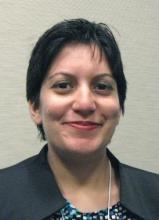SAN FRANCISCO – Symptoms improved significantly after 12 weeks of cognitive-behavioral therapy conducted via e-mail in a randomized, controlled trial in 62 adults with generalized anxiety disorder.
The trial randomized 69 patients who were diagnosed with generalized anxiety disorder via an hour-long online chat interview and who were not receiving any treatment. One group then participated in 12 weekly sessions of cognitive-behavioral therapy (CBT) by e-mail, and the control group received no treatment. Baseline scores on the Beck Anxiety Inventory (BAI) were approximately 42 in both groups.
At baseline, 35 patients started in the CBT group and 34, in the control group. At the end of 6 months there were 31 participants in each group. Among the 62 who completed the study, 43 were female, and 19 were male. The average age was 30.4 years in the CBT group and 29.8 years in the control group.
Among the 62 patients who completed 12 weeks of the study, only the e-mail CBT group had significantly improved anxiety scores after 12 weeks, and the results held steady at a 6-month follow-up online assessment, Dr. Nazanin Alavi reported at the annual meeting of the American Psychiatric Association.
The BAI score in the CBT group was 42 at the start, 19 after 12 weeks, and 20 after 6 months and in the control group, was 44 at the beginning, 43 after 12 weeks, and 44 after 6 months, said Dr. Alavi, a psychiatry resident at Queen’s University, Kingston, Ont. She reported the results at a press briefing and in a poster presentation at the meeting.
The findings suggest that CBT via e-mail may be a useful alternative when in-person interactions between patients and therapists are not possible. "Despite the proven short- and long-term efficacy of psychotherapy, it is not accessible to many people," Dr. Alavi said.
Barriers such as long waiting lists in urban areas or shortages of mental health providers in remote areas may prevent or delay people from getting help. Immigrants who do not share the prime language and cultural traditions of the dominant population may prefer working with a mental health provider from their home country, but those providers may be scarce in number and located geographically far from some patients. Online CBT may be a helpful adjunct in these settings, she said.
The current study, for example, enrolled Farsi-speaking patients of Persian background.
A future study should compare e-mail CBT with in-person CBT, Dr. Alavi added.
E-mail CBT is limited by the need for access to computers and the Internet, and therapists are unable to see or hear patients’ affects when communicating by e-mail. Because the interactions are asynchronous, a patient who has a question about slides or other therapeutic material presented one week may not receive an answer to questions until the next week’s session. On the other hand, Dr. Alavi noted, therapists can process a weekly e-mail session for one patient in approximately 20 minutes, and so can handle three patients in an hour, compared with one patient in an hour-long session in person or via virtual face-to-face online technology such as Skype.
The study excluded patients who had suicidal ideation or who were starting pharmacotherapy or psychotherapy. Patients randomized to the control group were told that they could seek psychotherapy elsewhere and were asked to inform the investigators if they did so; those who sought psychotherapy elsewhere were excluded from the analysis.
Dr. Alavi reported having no relevant financial disclosures.
On Twitter @sherryboschert


